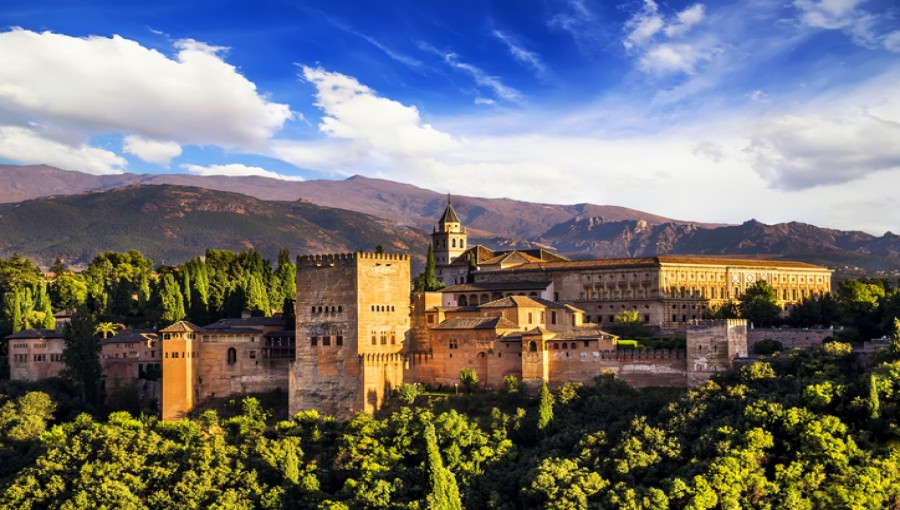Nestled amidst the stunning landscapes of Granada, Spain, the Alhambra stands as a testament to the grandeur of Islamic architecture and the rich cultural heritage of Andalusia. This iconic fortress-palace complex, renowned for its intricate designs, lush gardens, and storied history, continues to captivate visitors from around the globe. Rising majestically on a plateau overlooking Granada, the Alhambra is not only a mosque but also a breathtaking palace and fortress complex. Its rich tapestry of history, captivating architecture, and enduring legacy have secured its position as a UNESCO World Heritage Site and a captivating landmark. Perched on the Sabika hill, the Alhambra stands as a testament to the grandeur of Muslim rule in the Iberian Peninsula. Its name, derived from the Arabic 'al-Qasr al-Hamra' meaning 'Red Castle', reflects the reddish hue of its outer walls, a characteristic that has captivated visitors for centuries. Join us as we embark on a journey through time to unravel the mysteries and marvels of the Alhambra, a jewel of Muslim society and a beacon of artistic excellence.
Origins and Architecture: Tracing the Roots of Islamic Splendor
The Alhambra, meaning "the red fortress" in Arabic, stands as a masterpiece of Islamic architecture, owing its origins to the Nasrid dynasty, the last Muslim rulers of Spain. Construction of this breathtaking complex began in the 13th century, during the reign of Muhammad I, and continued through successive generations, culminating in a captivating blend of palaces, courtyards, gardens, and defensive structures, each intricately designed to harmonize with the natural landscape and reflect the Islamic concept of paradise on earth. The Alhambra's distinctive features include ornate stucco work, intricate tile mosaics, carved woodwork, and serene water features, all meticulously crafted to create a sense of serenity and beauty.

The roots of the Alhambra trace back to the 11th century, but it was during the Nasrid Dynasty that it flourished as a palatine city. Muhammad I Ibn al-Ahmar, the founder of the Emirate of Granada, initiated its construction in 1238, marking the beginning of the last Muslim state in Al-Andalus. The fortress complex served as a royal residence, a court of Granada, and a military base, reflecting the political and cultural zenith of the Nasrid reign. The Alhambra's architecture is a harmonious blend of Islamic art and Western Christian influences, showcasing intricate stucco work, geometric tile patterns, and ornate gardens. The complex includes the Alcazaba, the military quarter; the Nasrid Palaces, with the famous Court of the Lions; and the Generalife, a summer palace with lush gardens. Each element of the Alhambra's design serves as a narrative of a bygone era, where art and architecture were employed to symbolize power and religious devotion.
Read: Sultan Omar Ali Saifuddin Mosque
Cultural Significance: A Beacon of Islamic Civilization
The Alhambra's story begins in the 9th century, shrouded in mystery. The earliest documented evidence points to a defensive structure, the Alcazaba, possibly pre-dating Muslim presence in Granada. Historical records suggest that Sawwar ben Hamdun, a military leader, sought refuge and repaired the Alcazaba in 889. The Alhambra truly flourished under the Nasrid dynasty, the last Muslim kingdom in Western Europe. Founded by Mohammed I Ibn al-Ahmar in 1238, the Alhambra transformed from a military outpost into a royal residence and court. Successive Nasrid rulers oversaw the construction of magnificent palaces and gardens, ushering in the Alhambra's "Golden Age." The architectural style is a captivating blend of Islamic and Andalusi influences, with intricate stuccowork adorning the walls, showcasing geometric patterns and calligraphy verses from the Quran. Courtyards provide light and ventilation, while also serving as social and reflective spaces. Water, a symbol of life in Islam, plays a central role, with fountains and reflecting pools creating a sense of tranquility. The use of light and shadow creates a mesmerizing and ever-changing atmosphere.

The Alhambra, with its captivating blend of Islamic and Andalusi influences, showcases intricate stuccowork adorning the walls, geometric patterns, and calligraphy verses from the Quran. Courtyards provide light and ventilation, while also serving as social and reflective spaces. Water, a symbol of life in Islam, plays a central role, with fountains and reflecting pools creating a sense of tranquility. The use of light and shadow creates a mesmerizing and ever-changing atmosphere.
The Alhambra, a self-contained palace-city surrounded by fortifications, was built up by the Nasrid rulers of the Emirate of Granada in the 13th to 15th centuries. Multiple palaces were added and expanded over the years by different rulers. The Palace of the Lions was added by Muhammad V, who is also responsible for other important contributions to the Alhambra. The period of Muhammad V's reign is considered by scholars to mark the apogee of Nasrid architecture, characterized in particular by a profusive use of muqarnas (stalactite-like sculpting) and three-dimensional muqarnas vaults.
Legacy and Influence: Inspiring Generations
Despite the fall of Muslim rule in Spain in the late 15th century, the legacy of Alhambra endures as a testament to the enduring influence of Islamic culture and civilization in Europe. Its architectural innovations and artistic achievements continue to inspire architects, artists, and scholars to this day, serving as a bridge between East and West and fostering cross-cultural dialogue and appreciation.
Read: A Symbol of Islamic Grandeur
The preservation of Alhambra as a UNESCO World Heritage Site underscores its universal value and significance as a cultural treasure of humanity. Through careful conservation efforts and ongoing research, scholars and experts continue to uncover new insights into the history, art, and architecture of this remarkable monument, ensuring that its legacy will endure for future generations to cherish and learn from.
Reflecting on the Splendor of Alhambra
As we reflect on the majesty of Alhambra and its profound significance in the tapestry of Islamic civilization, we are reminded of the enduring power of art, culture, and heritage to transcend boundaries and unite humanity. In an increasingly interconnected world, the lessons of Alhambra resonate more strongly than ever, urging us to embrace diversity, foster understanding, and preserve the treasures of our shared heritage for generations to come.































Comment: